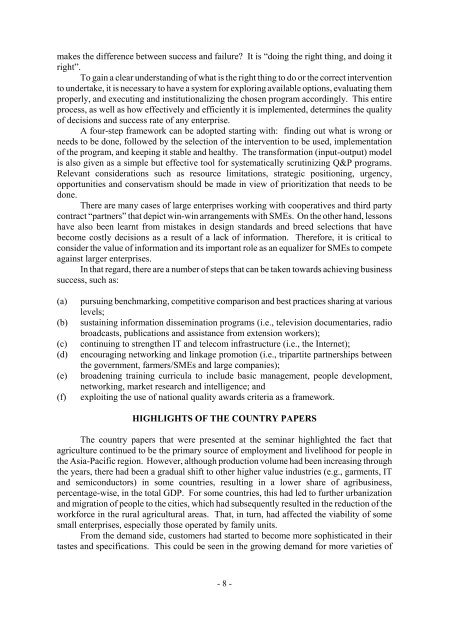Development of Agribusiness Enterprises - Asian Productivity ...
Development of Agribusiness Enterprises - Asian Productivity ...
Development of Agribusiness Enterprises - Asian Productivity ...
Create successful ePaper yourself
Turn your PDF publications into a flip-book with our unique Google optimized e-Paper software.
makes the difference between success and failure? It is “doing the right thing, and doing it<br />
right”.<br />
To gain a clear understanding <strong>of</strong> what is the right thing to do or the correct intervention<br />
to undertake, it is necessary to have a system for exploring available options, evaluating them<br />
properly, and executing and institutionalizing the chosen program accordingly. This entire<br />
process, as well as how effectively and efficiently it is implemented, determines the quality<br />
<strong>of</strong> decisions and success rate <strong>of</strong> any enterprise.<br />
A four-step framework can be adopted starting with: finding out what is wrong or<br />
needs to be done, followed by the selection <strong>of</strong> the intervention to be used, implementation<br />
<strong>of</strong> the program, and keeping it stable and healthy. The transformation (input-output) model<br />
is also given as a simple but effective tool for systematically scrutinizing Q&P programs.<br />
Relevant considerations such as resource limitations, strategic positioning, urgency,<br />
opportunities and conservatism should be made in view <strong>of</strong> prioritization that needs to be<br />
done.<br />
There are many cases <strong>of</strong> large enterprises working with cooperatives and third party<br />
contract “partners” that depict win-win arrangements with SMEs. On the other hand, lessons<br />
have also been learnt from mistakes in design standards and breed selections that have<br />
become costly decisions as a result <strong>of</strong> a lack <strong>of</strong> information. Therefore, it is critical to<br />
consider the value <strong>of</strong> information and its important role as an equalizer for SMEs to compete<br />
against larger enterprises.<br />
In that regard, there are a number <strong>of</strong> steps that can be taken towards achieving business<br />
success, such as:<br />
(a) pursuing benchmarking, competitive comparison and best practices sharing at various<br />
levels;<br />
(b) sustaining information dissemination programs (i.e., television documentaries, radio<br />
broadcasts, publications and assistance from extension workers);<br />
(c) continuing to strengthen IT and telecom infrastructure (i.e., the Internet);<br />
(d) encouraging networking and linkage promotion (i.e., tripartite partnerships between<br />
the government, farmers/SMEs and large companies);<br />
(e) broadening training curricula to include basic management, people development,<br />
networking, market research and intelligence; and<br />
(f) exploiting the use <strong>of</strong> national quality awards criteria as a framework.<br />
HIGHLIGHTS OF THE COUNTRY PAPERS<br />
The country papers that were presented at the seminar highlighted the fact that<br />
agriculture continued to be the primary source <strong>of</strong> employment and livelihood for people in<br />
the Asia-Pacific region. However, although production volume had been increasing through<br />
the years, there had been a gradual shift to other higher value industries (e.g., garments, IT<br />
and semiconductors) in some countries, resulting in a lower share <strong>of</strong> agribusiness,<br />
percentage-wise, in the total GDP. For some countries, this had led to further urbanization<br />
and migration <strong>of</strong> people to the cities, which had subsequently resulted in the reduction <strong>of</strong> the<br />
workforce in the rural agricultural areas. That, in turn, had affected the viability <strong>of</strong> some<br />
small enterprises, especially those operated by family units.<br />
From the demand side, customers had started to become more sophisticated in their<br />
tastes and specifications. This could be seen in the growing demand for more varieties <strong>of</strong><br />
- 8 -
















